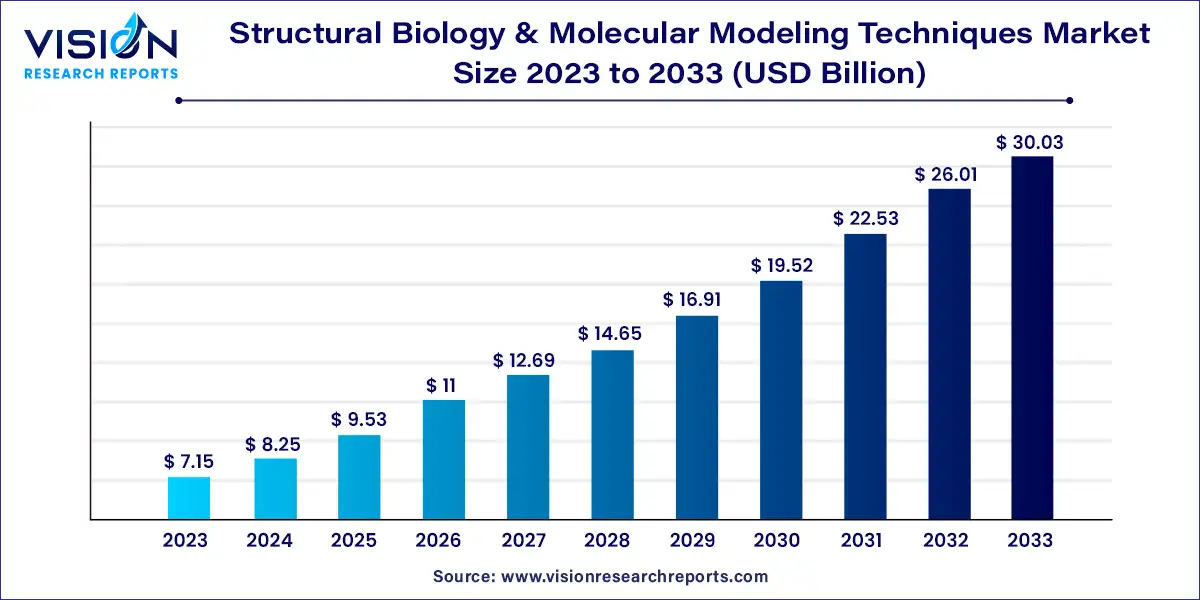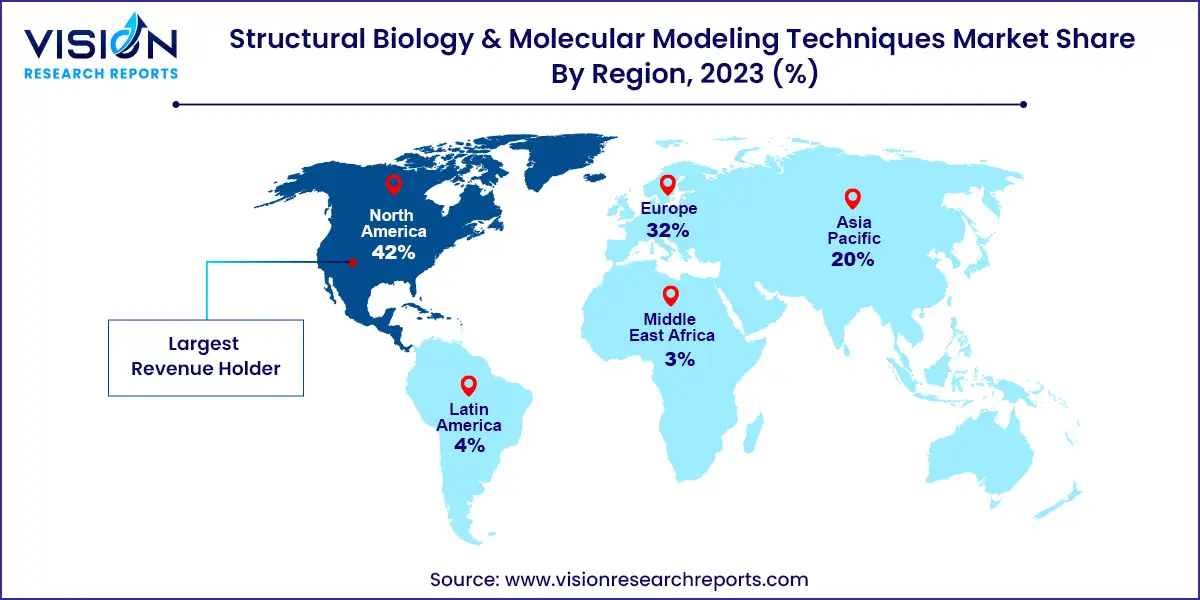Structural Biology and Molecular Modeling Techniques Market Size and Growth 2024 to 2033
The global structural biology and molecular modeling techniques market size was valued at USD 7.15 billion in 2023 and is anticipated to reach around USD 30.03 billion by 2033, growing at a CAGR of 15.43% from 2024 to 2033. The structural biology and molecular modeling techniques market is a dynamic sector that plays a crucial role in understanding biological macromolecules and their functions. This field integrates various advanced techniques to study the structure and behavior of proteins, nucleic acids, and other biomolecules. The advancements in this market are driving innovations in drug discovery, biotechnology, and personalized medicine.

Key Pointers
- North America dominated the global market with the largest market share of 42% in 2023.
- By Tool, the SaaS (Software as a Service) and standalone modeling tools captured the maximum market share of 41% in 2023.
- By Tool, the segment for visualization and analysis tools is projected to grow at the highest CAGR of 16.33% from 2024 to 2033.
- By Application, the drug development applications held the largest market revenue share of 50% in 2023.
- By Application, the drug discovery application segment is expected to grow at a CAGR of 14.73% from 2024 to 2033.
What are the Growth Factors of Structural Biology and Molecular Modeling Techniques Market?
The structural biology and molecular modeling techniques market is experiencing robust growth driven by an advance in computational power and algorithms are enabling more precise and efficient molecular modeling, thus accelerating research and drug development. Additionally, the rising prevalence of chronic diseases and the demand for personalized medicine are fueling investments in these techniques. The increasing integration of structural biology with other fields such as genomics and proteomics further enhances its application in understanding complex biological systems. Moreover, the expansion of research and development activities in biotechnology and pharmaceutical sectors, coupled with growing public and private funding, are significantly contributing to the market's expansion.
Case Studies in the Structural Biology and Molecular Modeling Techniques Market
Case Study 1: Drug Discovery for Cancer Treatment
Overview
In a major pharmaceutical company, structural biology and molecular modeling techniques were employed to develop a new drug for cancer treatment. The goal was to identify and validate novel drug targets and design a compound with high specificity for these targets.
Implementation
- Target Identification: Researchers used X-ray crystallography to determine the 3D structure of a key protein involved in cancer progression.
- Molecular Modeling: Computational molecular modeling techniques, including molecular docking and dynamics simulations, were applied to predict how potential drug candidates would interact with the identified protein target.
- High-Throughput Screening: A virtual screening approach was used to evaluate a large library of compounds for potential efficacy against the target.
- Lead Optimization: The most promising compounds were refined through iterative rounds of modeling and biological testing to improve their potency and selectivity.
Outcomes
- Discovery of a Novel Drug: The process led to the development of a new drug candidate that showed significant effectiveness in preclinical models.
- Accelerated Development: The integration of structural biology and molecular modeling reduced the drug discovery timeline by several months, expediting the transition to clinical trials.
- Target Validation: The techniques provided strong evidence supporting the role of the target protein in cancer, leading to a better understanding of the disease mechanism.
Case Study 2: Development of an Alzheimer's Disease Treatment
Overview
A research institute aimed to develop a therapeutic approach for Alzheimer's disease using structural biology and molecular modeling techniques to design a drug that could target amyloid-beta plaques, a hallmark of the disease.
Implementation
- Cryo-EM Analysis: Researchers employed Cryo-Electron Microscopy (Cryo-EM) to visualize the structure of amyloid-beta plaques at high resolution.
- Molecular Dynamics Simulations: Molecular dynamics simulations were used to study the interactions between amyloid-beta plaques and potential therapeutic molecules.
- Structure-Based Drug Design: The structural data from Cryo-EM were used to design and optimize small molecules that could bind effectively to the plaques.
- Preclinical Testing: The designed compounds were tested in animal models to assess their ability to reduce plaque formation and improve cognitive function.
Outcomes
- Effective Therapeutics: Several compounds demonstrated the ability to reduce amyloid-beta plaque load in preclinical models.
- Enhanced Understanding: The study provided valuable insights into the structural characteristics of amyloid-beta plaques and their interactions with potential drugs.
- Progress to Clinical Trials: Promising candidates were selected for further development and entered clinical trials, bringing the research closer to potential therapeutic applications.
What are the Trends in Structural Biology and Molecular Modeling Techniques Market?
- Integration of Artificial Intelligence (AI) and Machine Learning (ML): AI and ML are increasingly being used to analyze large datasets and predict molecular structures with greater accuracy. These technologies enhance the efficiency of modeling techniques and support the identification of novel drug targets.
- Advancements in Cryo-Electron Microscopy (Cryo-EM): Cryo-EM has gained prominence due to its ability to visualize proteins and complexes in their native state without the need for crystallization. Recent technological advancements are improving resolution and expanding applications in structural biology.
- Increased Focus on Protein-Protein Interactions: Research is increasingly focusing on understanding protein-protein interactions, which are critical for cellular functions and disease mechanisms. Techniques like Surface Plasmon Resonance (SPR) and X-ray crystallography are being applied to study these interactions in detail.
- Growth of Computational Molecular Modeling: The use of computational molecular modeling techniques, such as molecular dynamics simulations and quantum mechanical calculations, is growing. These methods are essential for predicting the behavior of molecules and understanding their interactions.
What are the Key Challenges Faced by Structural Biology and Molecular Modeling Techniques Market?
- High Costs of Advanced Equipment: The acquisition and maintenance of cutting-edge equipment such as high-resolution X-ray crystallography machines and advanced Cryo-EM setups involve significant financial investment. This high cost can be a barrier for smaller research institutions and companies.
- Complexity of Biological Systems: Modeling complex biological systems accurately remains a significant challenge. The inherent complexity and variability of biological macromolecules can make it difficult to create precise models and predict their behavior.
- Data Integration Issues: Integrating data from various structural biology techniques and computational models can be challenging. Discrepancies between different data sources can complicate the interpretation and analysis of biological information.
- Limited Resolution of Structural Techniques: Despite advancements, some structural techniques still face limitations in resolution. For example, while Cryo-EM has improved, it may not always achieve the atomic resolution needed for detailed structural analysis.
Which Region Dominates the Structural Biology and Molecular Modeling Techniques Market?
In 2023, North America led the structural biology and molecular modeling techniques market with a share of 42%. This dominance is due to stringent government policies, consistent regulatory support, and substantial investments in research and development, all contributing to increased market demand in the region.
Europe Structural Biology & Molecular Modeling Technique Market Trends
Europe's market for structural biology and molecular modeling techniques was notable in 2023 for its growth potential. Key factors driving this growth include ongoing innovations by research institutes, a focus on sustainable and eco-friendly products, and stringent environmental regulations. The UK, in particular, is anticipated to see significant growth due to increased government initiatives and the development of regional manufacturing hubs.

Asia Pacific Structural Biology & Molecular Modeling Technique Market Trends
The Asia Pacific region is expected to experience considerable growth in the structural biology and molecular modeling techniques market, driven by factors such as urbanization, rising incomes, an aging population, and increasing chronic disease prevalence. These factors are contributing to the significant expansion of the market in the region.
Tool Insights
In 2023, SaaS (Software as a Service) and standalone modeling tools collectively represented 41% of the market revenue. This growth is attributed to the vital role these tools play in managing chronic diseases and addressing emerging health threats. Extensively used in pharmaceutical research and drug design, these tools encompass a variety of offerings including virtual reality, cloud-based solutions, and other advanced technologies. Their diverse capabilities have significantly boosted demand among structural biologists, leading to a broad market expansion.
The segment for visualization and analysis tools is projected to grow at the highest CAGR of 16.33% from 2024 to 2033. This rapid growth is driven by advancements that enhance researchers' ability to analyze intricate biological structures and gain insights into molecular properties and biological complexities. These tools offer advanced features such as high-performance graphics, macromolecule streaming, and 3D visualization, contributing to their expected growth in the coming years.
Application Insights
Drug development applications held the largest market revenue share of 50% in 2023. This segment includes various stages of drug development, including lead optimization, preclinical testing, and clinical trials, underscoring the critical role of structural biology and molecular modeling techniques in understanding disease mechanisms, validating drug targets, and developing effective therapies. The growing need for innovative treatments for chronic and infectious diseases has driven significant investments in this area, boosting its market share.
The drug discovery application segment is expected to grow at a CAGR of 14.73% from 2024 to 2033. This growth is driven by technological innovations such as Virtual Screening (VS) and AI-powered molecular docking, which have streamlined and enhanced the drug discovery process. These state-of-the-art tools have made the process more rational, cost-effective, time-efficient, and capable of screening larger compound libraries, leading to earlier identification of drug-like properties.
Who are the Top Manufactures in Structural Biology and Molecular Modeling Techniques Market?
- Acellera Therapeutics Inc.
- Agilent Technologies, Inc.
- Labvantage - Biomax GmbH
- Bruker
- Chemical Computing Group ULC
- Dassault Systèmes
- Illumina, Inc.
- Thermo Fisher Scientific Inc.
- CD BioSciences
- Charles River Systems, Inc.
Structural Biology and Molecular Modeling Techniques Market Segmentation:
By Tools
- SaaS & Standalone Modeling
- Visualization & Analysis
- Databases
- Others
By Application
- Drug Development
- Drug Discovery
- Others
By Region
- North America
- Europe
- Asia Pacific
- Latin America
- Middle East and Africa (MEA)
Frequently Asked Questions
The global structural biology and molecular modeling techniques market size was reached at USD 7.15 billion in 2023 and it is projected to hit around USD 30.03 billion by 2033.
The global structural biology and molecular modeling techniques market is growing at a compound annual growth rate (CAGR) of 15.43% from 2024 to 2033.
The North America region has accounted for the largest structural biology and molecular modeling techniques market share in 2023.
The leading companies operating in the structural biology and molecular modeling techniques market are Acellera Therapeutics Inc; Agilent Technologies, Inc; Labvantage - Biomax GmbH; Bruker; Chemical Computing Group ULC; Dassault Systèmes; Illumina, Inc.; Thermo Fisher Scientific Inc.; CD BioSciences and Charles River Systems, Inc.


 Cross-segment Market Size and Analysis for
Mentioned Segments
Cross-segment Market Size and Analysis for
Mentioned Segments
 Additional Company Profiles (Upto 5 With No Cost)
Additional Company Profiles (Upto 5 With No Cost)
 Additional Countries (Apart From Mentioned Countries)
Additional Countries (Apart From Mentioned Countries)
 Country/Region-specific Report
Country/Region-specific Report
 Go To Market Strategy
Go To Market Strategy
 Region Specific Market Dynamics
Region Specific Market Dynamics Region Level Market Share
Region Level Market Share Import Export Analysis
Import Export Analysis Production Analysis
Production Analysis Others
Others